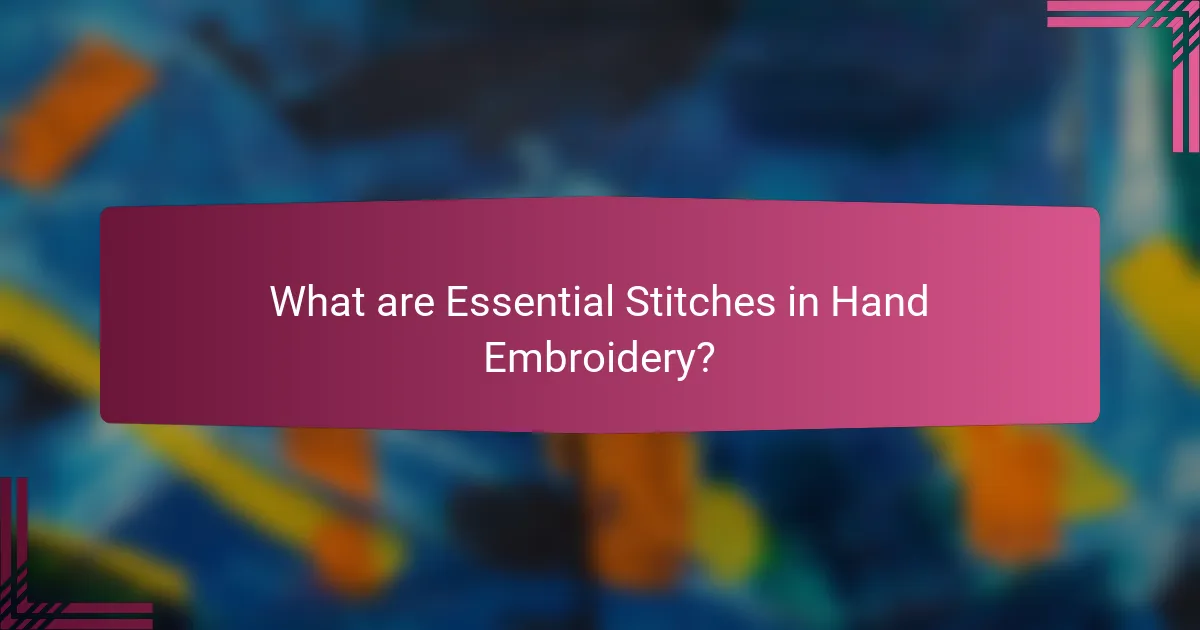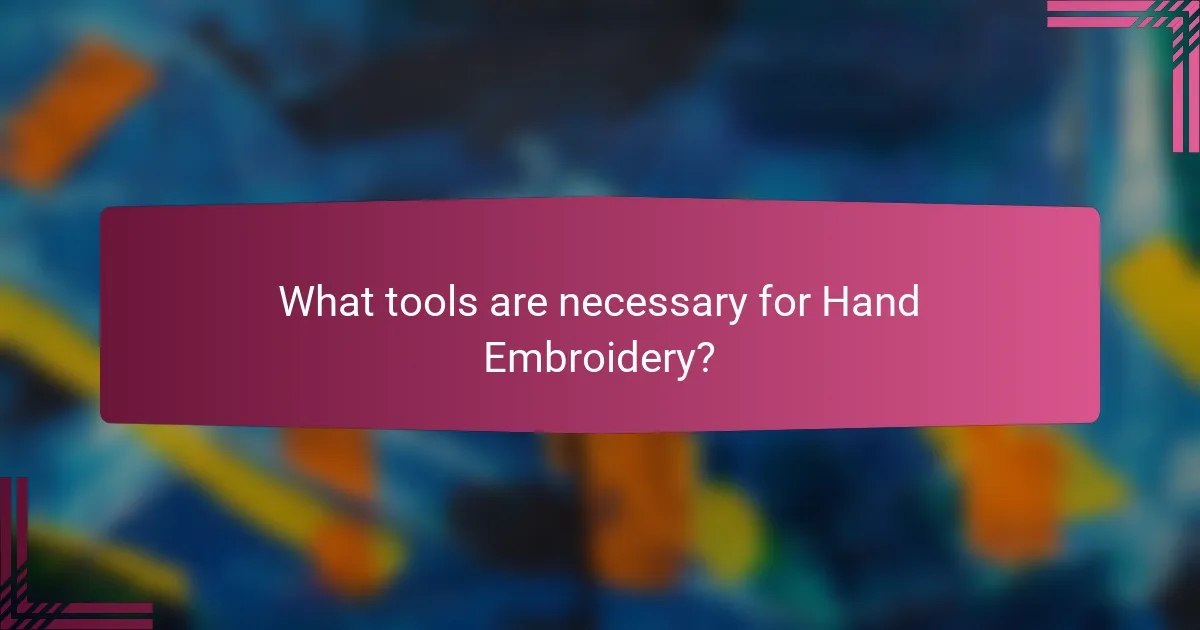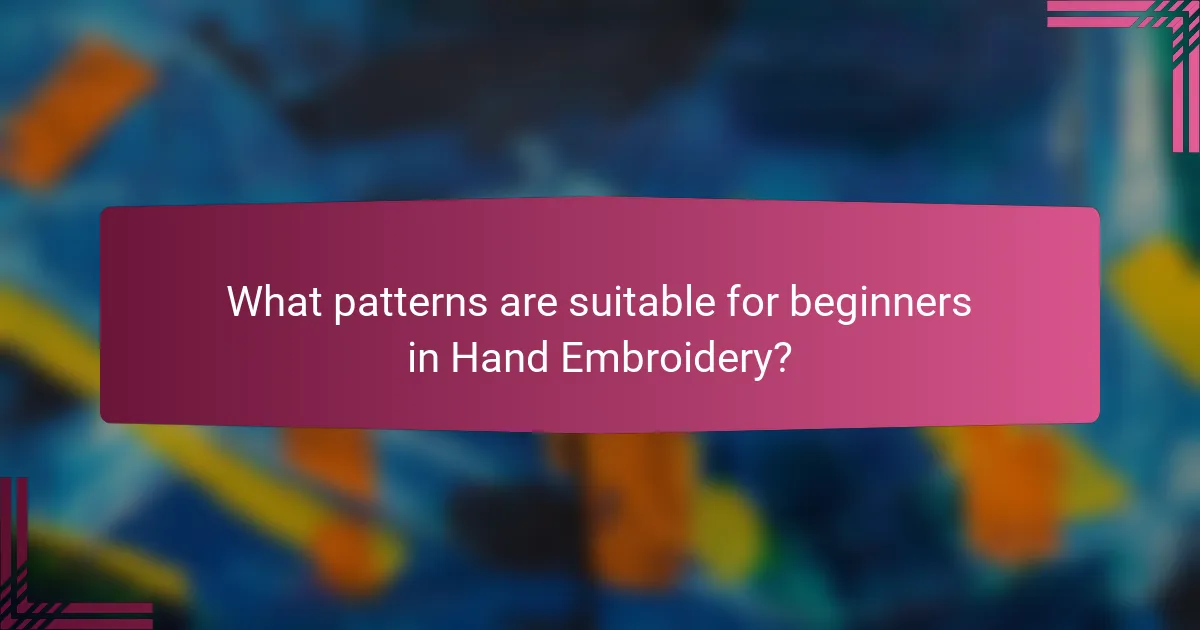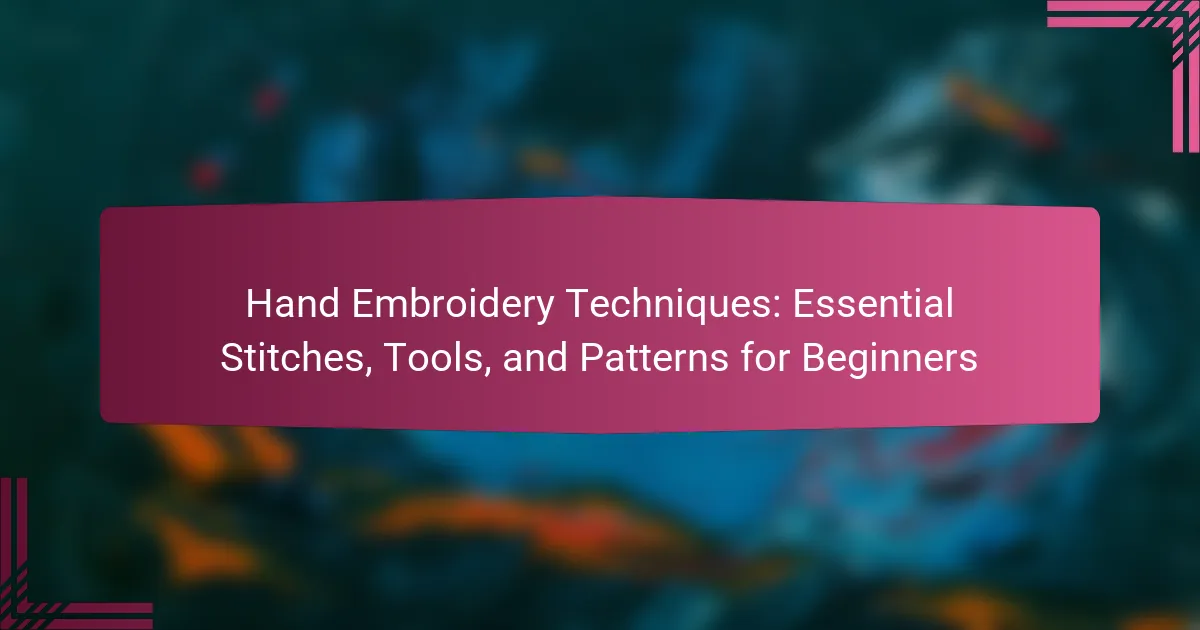
What are Hand Embroidery Techniques?
Hand embroidery techniques are methods used to create decorative designs on fabric with needle and thread. These techniques include various stitches such as backstitch, satin stitch, and French knots. Each stitch serves a different purpose and contributes to the overall design. Hand embroidery has been practiced for centuries, with origins tracing back to ancient civilizations. Specific techniques can vary by culture and region, showcasing unique styles and patterns. Mastery of these techniques allows for intricate and personalized textile art.
How did Hand Embroidery Techniques evolve over time?
Hand embroidery techniques evolved significantly from ancient times to modern practices. Initially, hand embroidery was used for functional and decorative purposes on clothing and textiles. Techniques were often passed down through generations, with regional styles developing unique characteristics.
In the Middle Ages, embroidery became a symbol of wealth and status, featuring intricate designs and rich materials. The Renaissance introduced more artistic approaches, with the incorporation of perspective and shading.
The Industrial Revolution brought about mass production, which affected traditional hand embroidery practices. However, this led to a resurgence of interest in handmade crafts in the late 19th and early 20th centuries.
Today, contemporary hand embroidery includes a blend of traditional techniques and modern aesthetics. Artists now experiment with diverse materials and innovative designs, expanding the boundaries of what hand embroidery can represent.
What historical influences shaped modern Hand Embroidery Techniques?
Modern hand embroidery techniques are shaped by various historical influences. The origins of embroidery trace back to ancient civilizations, such as Egypt and China, where decorative stitching was used for both functional and aesthetic purposes. During the Middle Ages, embroidery became a prominent art form in Europe, with religious themes dominating the designs. The Renaissance period introduced more intricate patterns and the use of silk threads, enhancing the visual appeal of embroidery.
Colonial trade routes facilitated the exchange of techniques and materials, leading to the development of unique regional styles. The Industrial Revolution brought about mechanization, which influenced hand embroidery by introducing new tools and fabrics. Cultural movements, such as Arts and Crafts in the late 19th century, emphasized handmade techniques, reviving interest in traditional embroidery methods.
Today, modern hand embroidery incorporates these historical elements while also embracing contemporary themes and innovation. The blending of past influences with modern creativity continues to shape the evolution of hand embroidery techniques.
How do cultural variations impact Hand Embroidery Techniques?
Cultural variations significantly influence hand embroidery techniques. Different cultures have unique patterns, stitches, and color palettes. For instance, Indian embroidery often features vibrant colors and intricate designs, reflecting local traditions. Conversely, Scandinavian embroidery tends to use muted tones and geometric patterns, showcasing regional aesthetics. Techniques such as cross-stitching in Eastern Europe differ from the free-form styles seen in African textiles. The materials used also vary; silk is common in Asian embroidery, while wool is prevalent in Nordic designs. These cultural distinctions highlight the diversity and richness of hand embroidery practices globally.
What are the fundamental components of Hand Embroidery Techniques?
The fundamental components of hand embroidery techniques include stitches, tools, and fabrics. Stitches are the basic building blocks of embroidery. Common stitches include backstitch, satin stitch, and French knot. Tools necessary for hand embroidery are needles, embroidery hoops, and threads. Fabrics used can vary widely, including cotton, linen, and silk. Each component plays a crucial role in creating intricate designs. Mastery of these elements allows for a range of artistic expression in embroidery.
What tools are essential for beginners in Hand Embroidery?
Essential tools for beginners in hand embroidery include an embroidery hoop, needles, and thread. An embroidery hoop holds fabric taut while stitching. Needles used should be appropriate for embroidery, typically with a larger eye for easy threading. Thread can be embroidery floss or specialty threads, offering various colors and textures. Scissors are also necessary for cutting threads cleanly. A fabric marker helps in transferring patterns onto fabric. Finally, a needle threader can assist in threading needles easily. These tools collectively enable beginners to start their hand embroidery projects effectively.
What types of fabrics are best suited for Hand Embroidery?
Cotton, linen, and silk are the best fabrics for hand embroidery. Cotton is widely used due to its durability and ease of handling. Linen offers a natural texture that enhances the embroidery design. Silk provides a luxurious finish but requires careful handling. These fabrics have a tight weave, which supports intricate stitches. They also hold color well, ensuring vibrant designs. Additionally, they are available in various weights, allowing for versatility in projects.
What are the key benefits of learning Hand Embroidery Techniques?
Learning hand embroidery techniques enhances creativity and self-expression. It allows individuals to create personalized and unique designs. Mastering hand embroidery can improve fine motor skills and hand-eye coordination. Engaging in this craft can also provide stress relief and promote mindfulness. Additionally, hand embroidery fosters a sense of accomplishment upon completing projects. It can serve as a social activity, connecting individuals through shared interests. Furthermore, hand embroidery techniques can be applied in various practical applications, such as home decor and fashion.
How does Hand Embroidery enhance creativity and mindfulness?
Hand embroidery enhances creativity and mindfulness by allowing individuals to express themselves through art. The process engages the mind and body, fostering focus and presence. Each stitch requires attention, which can lead to a meditative state. Research indicates that repetitive tasks, like embroidery, can reduce stress and anxiety. A study published in the Journal of Positive Psychology found that creative activities improve well-being. Additionally, embroidery encourages problem-solving as individuals choose colors and patterns. This creative decision-making can boost self-esteem and personal satisfaction. Overall, hand embroidery serves as a therapeutic outlet, promoting both creativity and mindfulness.
What practical applications can Hand Embroidery Techniques have?
Hand embroidery techniques have various practical applications. They are used in fashion design to create unique clothing items. Home decor often incorporates hand embroidery for personalized touches on textiles. Craft projects benefit from these techniques to enhance visual appeal. Educational settings use hand embroidery to teach fine motor skills. Gifts and personalized items frequently feature hand embroidery for sentimental value. Historical preservation relies on hand embroidery to maintain traditional textile arts. Additionally, therapeutic practices utilize hand embroidery for stress relief and mindfulness.

What are Essential Stitches in Hand Embroidery?
Essential stitches in hand embroidery are fundamental techniques used to create designs on fabric. These stitches include the running stitch, backstitch, satin stitch, and French knot. Each stitch serves a unique purpose and contributes to the overall design. The running stitch is often used for outlining and filling. The backstitch provides a strong line for detail work. The satin stitch is ideal for filling in shapes with solid color. The French knot adds texture and dimension to the embroidery. Mastering these essential stitches is crucial for beginners to develop their skills in hand embroidery.
Which stitches should every beginner learn first?
Every beginner should learn the straight stitch, backstitch, and chain stitch first. The straight stitch is fundamental for creating clean lines and outlines. The backstitch provides a strong, continuous line that is easy to master. The chain stitch adds texture and is useful for filling shapes. These stitches form the basis for more complex techniques. Mastering them builds confidence and skill in hand embroidery. They are commonly used in various projects, making them essential for beginners.
How do you execute a basic running stitch?
To execute a basic running stitch, first, thread a needle and knot the end. Insert the needle from the back of the fabric to the front at your starting point. Pull the needle through until the knot is secure against the fabric. Move the needle forward a short distance and insert it back down through the fabric. Pull the needle through to create the first stitch. Repeat this process, alternating between the front and back of the fabric. Maintain even spacing between each stitch for a uniform look. The running stitch is commonly used in hand embroidery for outlining and adding texture.
What techniques are involved in creating a back stitch?
The back stitch is created using a series of specific techniques. First, bring the needle up through the fabric at the starting point. Next, insert the needle back into the fabric a short distance ahead. Pull the thread through completely. Then, bring the needle back up through the fabric at the end of the previous stitch. Repeat these steps to create a continuous line. This technique forms a solid, defined stitch that is ideal for outlining shapes. The back stitch is commonly used in hand embroidery for its durability and neat appearance.
What are some decorative stitches that can enhance projects?
Decorative stitches that can enhance projects include satin stitch, French knot, and chain stitch. Satin stitch provides a smooth, shiny finish, ideal for filling shapes. French knots add texture and dimension, often used for floral designs. Chain stitch creates a linked, rope-like effect, suitable for outlining and embellishing. Other options include herringbone stitch, which offers a zigzag appearance, and blanket stitch, used for edging. Each stitch contributes unique visual appeal and texture to embroidery projects.
How can you incorporate satin stitch into your designs?
To incorporate satin stitch into your designs, start by selecting a design that features smooth, curved edges. Satin stitch is characterized by its flat and smooth finish, ideal for filling shapes. Use a single thread of embroidery floss for a more polished look. Begin stitching from the outside edge of the shape toward the center for even coverage. Keep your stitches parallel and close together to achieve a dense fill. Adjust the length of the stitches based on the size of the area being filled. Practice on scrap fabric to perfect your technique before applying it to your final design. This method ensures a professional appearance in your hand embroidery projects.
What is the purpose of using French knots in embroidery?
The purpose of using French knots in embroidery is to create textured, decorative elements. French knots add dimension to designs, enhancing visual interest. They are often used to represent flowers, berries, or other small details. This stitch can also provide a unique contrast to flat stitches. French knots are versatile and can be incorporated into various embroidery styles. They are a fundamental technique in hand embroidery. Mastery of this stitch is essential for beginners. The technique has been used in various cultures for centuries, underscoring its importance in textile art.

What tools are necessary for Hand Embroidery?
Essential tools for hand embroidery include embroidery needles, embroidery floss, fabric, scissors, and an embroidery hoop. Embroidery needles are specifically designed for hand stitching and come in various sizes. Embroidery floss is a type of thread made of six strands that can be separated for different thicknesses. The fabric serves as the base for the embroidery design, with popular options being cotton and linen. Scissors are necessary for cutting threads and trimming fabric edges. An embroidery hoop holds the fabric taut, making stitching easier and more precise. These tools are fundamental for executing hand embroidery techniques effectively.
What basic tools should beginners have for Hand Embroidery?
Beginners in hand embroidery should have a few basic tools. Essential tools include embroidery needles, which are specifically designed for hand stitching. A variety of thread, such as embroidery floss, is necessary for different colors and textures. An embroidery hoop helps keep fabric taut while working. Scissors for trimming thread are also important. A fabric marking pen aids in transferring designs onto the fabric. Finally, a needle threader can simplify the threading process. These tools collectively enhance the hand embroidery experience for beginners.
How do you choose the right embroidery needle?
To choose the right embroidery needle, consider the needle’s size and type. Needles come in various sizes, which affect the thickness of the thread and fabric. For fine fabrics, use a smaller needle, such as a size 9 or 10. For thicker fabrics, select a larger needle, like size 12 or 14.
Additionally, different needle types are designed for specific techniques. For instance, a sharp needle is ideal for detailed work, while a ballpoint needle is better for knits. The eye of the needle should accommodate the thread without causing fraying.
Using the correct needle ensures even stitching and prevents damage to the fabric. Choosing the right needle can enhance the overall quality of the embroidery project.
What types of embroidery hoops are available for beginners?
Beginners can choose from three main types of embroidery hoops: wooden, plastic, and metal. Wooden hoops are traditional and provide a sturdy grip. They are often preferred for their aesthetic appeal and durability. Plastic hoops are lightweight and usually come in various colors. They are affordable and easy to use for beginners. Metal hoops are less common but offer a sleek design. They tend to be more durable than plastic and are suitable for various fabric types. Each type has unique benefits that cater to beginners’ needs.
What additional tools can improve your Hand Embroidery experience?
Additional tools that can improve your hand embroidery experience include embroidery hoops, needles, and thread organizers. Embroidery hoops keep fabric taut, allowing for easier stitching. Needles designed specifically for embroidery have larger eyes for thicker threads. Thread organizers help prevent tangling and keep colors accessible. Scissors with fine tips are essential for precise cutting. Marking pens or pencils assist in transferring designs onto fabric. A thimble protects fingers during stitching. These tools enhance efficiency and quality in hand embroidery projects.
How can using fabric markers assist in your embroidery projects?
Using fabric markers can significantly enhance your embroidery projects. They provide a clear guideline for stitching, making it easier to follow intricate designs. Fabric markers are available in various colors, allowing for customization and creativity. They are water-soluble or fade-resistant, ensuring that the markings do not interfere with the final look. Many fabric markers dry quickly, which helps maintain project momentum. Additionally, they can be used to test color combinations before committing to embroidery. This versatility makes them an essential tool for both beginners and experienced embroiderers.
What role does embroidery floss play in your designs?
Embroidery floss is essential for creating intricate designs in hand embroidery. It provides the color and texture needed to bring patterns to life. The variety of colors available allows for creative expression and personalization. Different thread thicknesses can affect the overall appearance of the design. Embroidery floss can be easily separated into strands for finer detailing. This versatility makes it suitable for various stitches and techniques. Additionally, the durability of embroidery floss ensures that designs remain vibrant over time. Its role is pivotal in achieving both aesthetic appeal and structural integrity in embroidery projects.

What patterns are suitable for beginners in Hand Embroidery?
Simple geometric patterns are suitable for beginners in hand embroidery. These patterns often include basic shapes like circles, squares, and triangles. They provide a straightforward way to practice stitching techniques. Floral motifs are also beginner-friendly. They allow for creativity while using simple stitches. Animal shapes can be engaging and easy to replicate. Patterns with fewer details help beginners focus on mastering basic stitches. Additionally, projects like bookmarks or small decorative pieces are ideal for practice. These options build confidence and skill in hand embroidery.
How do you select beginner-friendly embroidery patterns?
To select beginner-friendly embroidery patterns, choose designs that feature simple shapes and fewer colors. Patterns with basic stitches, like straight or zigzag, are ideal for beginners. Look for patterns labeled as “easy” or “beginner” in craft stores or online. These patterns often include step-by-step instructions. Additionally, consider the size of the pattern; smaller designs are generally easier to manage. Avoid intricate details that require advanced techniques. Popular sources for beginner patterns include embroidery books and online platforms like Pinterest. These resources often provide a variety of options suited for novices.
What online resources offer free embroidery patterns for beginners?
Online resources that offer free embroidery patterns for beginners include websites like DMC, Sew Mama Sew, and Embroidery Library. DMC provides a variety of downloadable patterns and tutorials for all skill levels. Sew Mama Sew features beginner-friendly projects and pattern links. Embroidery Library offers free designs that can be easily accessed and downloaded. These resources are widely recognized for their quality and accessibility in the embroidery community.
How can you modify existing patterns to suit your style?
You can modify existing patterns by altering colors, sizes, and stitch types. Changing colors can reflect personal preferences and themes. Adjusting sizes allows for customization to fit specific projects. Experimenting with different stitch types can add texture and dimension. Layering stitches creates unique effects and enhances visual interest. Combining elements from multiple patterns can result in a distinctive design. Using these techniques ensures that the final piece aligns with your personal style.
What are some popular themes for beginner embroidery projects?
Popular themes for beginner embroidery projects include floral designs, animals, and simple geometric patterns. Floral designs are widely chosen for their beauty and variety. These projects often feature basic stitches like satin stitch and backstitch. Animal themes allow beginners to explore creativity with fun and recognizable shapes. Simple geometric patterns provide an easy way to practice precision and consistency. Other popular themes are inspirational quotes and seasonal motifs. These themes encourage personal expression and are suitable for various skill levels.
How can nature-inspired patterns enhance your embroidery skills?
Nature-inspired patterns can enhance your embroidery skills by providing diverse design elements. These patterns often include floral, animal, and landscape motifs. They encourage creativity and experimentation with colors and textures. Nature patterns can improve your understanding of composition and balance in embroidery. Working with these designs helps develop precision and attention to detail. Studies show that engaging with nature enhances artistic skills and promotes mindfulness. This connection can lead to more innovative and personal embroidery pieces. Nature-inspired patterns serve as a rich source of inspiration for both beginners and advanced embroiderers.
What simple geometric patterns are great for practice?
Simple geometric patterns great for practice include squares, triangles, and circles. These shapes are foundational in hand embroidery. Squares help develop precision and even stitching. Triangles enhance skills in creating angles and directional stitching. Circles improve control over curves and rounded shapes. Practicing these patterns builds confidence in basic techniques. Mastery of these shapes leads to more complex designs. They are commonly used in beginner embroidery projects. Engaging with these patterns fosters creativity and technique refinement.
What tips can help beginners succeed in Hand Embroidery?
To succeed in hand embroidery, beginners should start with simple patterns and stitches. Selecting high-quality materials enhances the overall experience. Using an embroidery hoop keeps fabric taut and manageable. Practicing basic stitches like the backstitch and satin stitch builds foundational skills. Keeping threads organized prevents tangling and confusion. Regularly referring to instructional resources, such as books or online tutorials, aids learning. Joining embroidery communities offers support and inspiration. Lastly, patience and practice are essential for improving technique and confidence.
Hand embroidery techniques encompass various methods for creating decorative designs on fabric using needle and thread, including essential stitches like backstitch and satin stitch. The article explores the evolution of these techniques, influenced by historical and cultural variations, while highlighting fundamental components such as tools and fabrics. It also addresses practical applications, benefits of learning hand embroidery, and provides guidance on selecting beginner-friendly patterns and essential tools. With a focus on enhancing creativity and mindfulness, the content serves as a comprehensive resource for those looking to start their hand embroidery journey.
